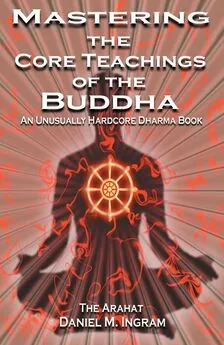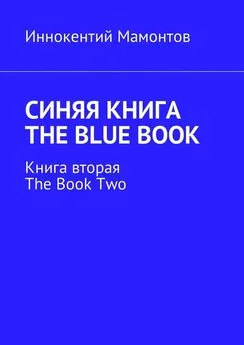Daniel Ingram - Mastering the Core Teachings of Buddha - An Unusually Hardcore Dharma Book
- Название:Mastering the Core Teachings of Buddha - An Unusually Hardcore Dharma Book
- Автор:
- Жанр:
- Издательство:Aeon Books
- Год:2009
- ISBN:9781904658405
- Рейтинг:
- Избранное:Добавить в избранное
-
Отзывы:
-
Ваша оценка:
Daniel Ingram - Mastering the Core Teachings of Buddha - An Unusually Hardcore Dharma Book краткое содержание
Mastering the Core Teachings of Buddha - An Unusually Hardcore Dharma Book - читать онлайн бесплатно полную версию (весь текст целиком)
Интервал:
Закладка:
somewhat deluded motivations, awakening would be impossible by definition.
Luckily, awakening is possible, and the only tool we have is practice based upon semi-deluded motivations. I am extremely grateful that this seems to be sufficient if we are willing to use what we have rather than fantasizing about some perfect us that doesn’t exist. Without greed, 122
Harnessing the Energy of the “Defilements”
rage, grandiosity, frustration, insecurity, fear and a host of other semi-deluded forces, we would hardly budge. We wouldn’t pick up dharma books, we wouldn’t go on retreats, we wouldn’t deal with our stuff, and we wouldn’t care at all. But we do care, and so we forge on. Thank the Metaphorical God for the power of our emotions and the pain the dark ones cause. They are the gasoline that drives us on the road to understanding.
123
18.RIGHT THOUGHT AND THE AEGEAN STABLES
There is a lot of emphasis on “right thought” and suppressing the mental “defilements” in Buddhism, as well as training in morality, “right speech” and that sort of thing. As these are agendas for what happens in our ordinary reality, they are aspects of training in morality. This emphasis on controlling our thoughts can be helpful but it has it limits and often causes problems when misunderstood. When this becomes the predominant thrust of one’s practice and involves images of self-perfection that deny the basic realities of human existence and the inevitable dark sides of life, trouble is basically guaranteed.
The Buddha did go on and on about restraining thought,
transforming thought, and that sort of thing. He was making a very important point, but he didn’t stop there. He also advocated that people go on to cultivate concentration and then insight, so as to temporarily quiet and then overcome forever the fundamental delusions that drive our noisy minds. This same point would apply to psychotherapy: it can be useful, but to find the end of suffering we must go much deeper.
Sutra #20 in The Middle Length Discourses of the Buddha (great book, by the way) is called “The Removal of Distracting Thoughts.” In it, Buddha admonished his followers to deal with unskillful, evil, unwholesome or useless thoughts in the following ways. First, if the student is paying attention to something that is causing these unskillful thoughts, then they should pay attention to something wholesome that does not produce unskillful thoughts. If this fails, then they should reflect on the danger in those thoughts and thus try to condition themselves to not think such thoughts in this way. If this fails, then they should try to forget those thoughts and not give any attention to them. If this fails, then they should give attention to quieting the mind and to stilling these thoughts. If this fails, then the student should bear down with their full will and “crush mind with mind,” forcing the thoughts to stop with unremitting and unrestrained effort. He also recommended the formal concentration practices of loving-kindness, compassion, sympathetic joy, and equanimity (see Lovingkindness, The
Revolutionary Art of Happiness, by Sharon Salzberg, or Training the Mind, by Chogyam Trungpa).
Right Thought and the Aegean Stables
Those familiar with cognitive restructuring will notice great similarities between this 2,500-year-old approach and more modern techniques. These can help develop morality and also suppress the hindrances that cause distraction and poor concentration, as well as begin to create better mental and personal habits. However, this can have its problems if not understood in a realistic and clear way.
A subtle but incorrect modification of these techniques can create a large amount of internal conflict, as can failing to understand the limitations of such techniques. The subtle modification that is definitely not recommended but all too common is the following: the student substitutes feelings of self-judgment or self-loathing for the thoughts they feel are unskillful. This results from only seeing the ignorance side and not the compassion side of intentions and thoughts. It can produce some extremely detrimental results, as well as highly neurotic and repressed individuals who are in basic denial of their actual humanity and heart. It can produce students who are quite bitter, tight, judgmental, Puritanical, and generally unpleasant to be around. This is one extreme.
The other extreme tends to come when people only focus on the compassion side of their emotions and not the confusion and suffering that can be mixed in with them. Aspects of late 1960s come to mind.
This error can lead to extreme misunderstandings of Tantra, unhealthy Epicureanism, addictions, and general debauchery that are simply destructive. While this may seem fun and “liberating” for a while, the consequences tend to be as bad as would be expected. Thus, a sophisticated examination of our hearts, desires, aversions and confusions can help sort out what aspects of these are skillful and worth cultivating and what aspects are unhelpful and worth abandoning by the various methods available.
The last problem comes from not understanding that the only way to really bring some permanent relief from these persistent and somewhat uncontrollable thoughts is to get quite enlightened. Until this happens, even in the early stages of awakening, the “defilements” of the mind will continue to cause the creation of all kinds of unhelpful thoughts and mind noise that are easy to get caught in and fooled by.
Thus, while training in thought restraint can be very helpful and is highly 125
Right Thought and the Aegean Stables
recommended, it should not be viewed as being more powerful than it is. Remember that training in morality and concentration does not produce awakening without training in insight. This point is mentioned again and again, but somehow continues to be overlooked.
A useful analogy is that of the Aegean Stables. The story goes that one of Hercules’ tasks was to clean the Aegean Stables. These housed a very large number of horses that continually produced great mounds of excrement. He tried again and again with superhuman strength to clean them, but there were too many horses producing too much excrement too fast for him. As soon as he had cleaned one area, the other areas were full of manure, and so he despaired. However, when he diverted a great river through the stables, this was able to wash the whole of the stables clean at once, and his task was accomplished. While the sensations that make up our reality are still misunderstood, we can feel a bit like Hercules before he diverted the river. This is par for the course and normal.
Enlightenment is a sudden thing, but the cultivation of that initial awakening is a gradual thing and proceeds in fairly predictable stages (detailed in Part III). For more information on this topic, I recommend the excellent works of Chi Nul, presented in Tracing Back the Radiance as translated by Robert Buswell. At each progressive stage, certain unhelpful patterns of identification with experience are forever eliminated or overcome, sort of like channeling a river through one part of the stables, but many more remain until final and complete awakening. Thus, the mind becomes progressively clearer, more spacious and quieter, and those unskillful thoughts regarding identification that do arise are more likely to be caught before they can do damage.
Thus, those who wish for the end of suffering should strive to be kind, stabilize the mind, and carefully and precisely understand the actual truth of their experience in each moment in a way that goes beyond content.
126
19.FROM CONTENT TO INSIGHT
In the previous chapter, I explained a method of cognitive
restructuring that was designed to help us stop thinking distracting or unhelpful thoughts. As those techniques have an agenda for what happens, rather than an agenda for perceiving something fundamental about whatever happens, they are an aspect of training in morality or concentration. However, if we are willing to realize that we can also take an insight-oriented perspective on difficult or distracting thoughts, either on the cushion or when walking around, then we can begin to make the transition from content to insight.
As you would expect, this method is grounded squarely in the Three Characteristics, as well as the other basic assumptions of insight practices, such as one’s current sensate experience being the gold standard for reality. This method is probably best shown by way of examples, in this case of a few people with a Big Issue who are on an insight meditation retreat and reporting their experiences to their teacher.
The first example is of someone who is completely buying into the content. “So, in my practice I have been working through my Big Issue, you know, really trying to deal with it. It just seems to come back again and again. Every time I sit on the cushion, I find myself thinking about my Big Issue again. This Big Issue is such a big part of my life, such a huge issue. I am afraid that if I look too closely at my Big Issue it will overwhelm me. I wish my Big Issue would just go away. I have been doing so much practice, and yet I still have to deal with this darned Big Issue.” Notice that the person assumes continuity of the existence of the Big Issue. They also assume that all thoughts about the Big Issue are either self, the property of self, or separate from self. Further, they are not working at a sensate level, trying to see the true nature of the thoughts and physical sensations that make up the Big Issue and the rest of their reality. In short, the “practice” they mention is some sort of practice other than insight practice. Let’s try that again.
“I sat down on the cushion, and I had barely begun to practice noticing my breath when a thought about my Big Issue arose. I tried to ignore it, but then more thoughts about Big Issue arose, and my stomach began to feel queasy. I tried to focus on the breath again, but
From Content to Insight
then I found myself thinking about the Big Issue again, thought after thought, mostly the same old thoughts repeating again and again.”
This person is already making progress towards using these thoughts and physical sensations as a basis for insights. They are beginning to try to apply the assumptions of insight practices to their experience. They are trying to focus on a physical object, trying to notice the individual sensations that make up their thoughts and physical sensations.
However, they have poor concentration and have not learned to see the true nature of the sensations that make these up.
“I sat down on the cushion, and I tried to see each of the sensations that make up the breath. Interspersed with these physical sensations were mental images of the breath. Interspersed with all of these sensations were also thoughts about the Big Issue. They were quick and seemed to also involve some mildly painful or disconcerting physical sensations in the region of my stomach. I could see these come and go and that they were observed. I could feel as they arose that there was something irritating about these quick sensations.
“I noticed that most of my experience was made of sensations that didn’t seem to relate to that Big Issue. Sometimes I noticed the three characteristics of the sensations that seem to be related to the old Big Issue pattern of sensations, and sometimes I was able to stay with the sensations of breathing. However, regardless of which sensations arose, I was generally able to see some aspect of the true nature of them. Thus, I find that I am able to keep practicing and not get lost in old, circular thoughts about that Big Issue that do me little good and have caused me much pain.”
Читать дальшеИнтервал:
Закладка:





![Дженнифер Гюнтер - The vagina book. Главная книга для тех, у кого есть этот орган [litres]](/books/1061538/dzhennifer-gyunter-the-vagina-book-glavnaya-kniga-dl.webp)




